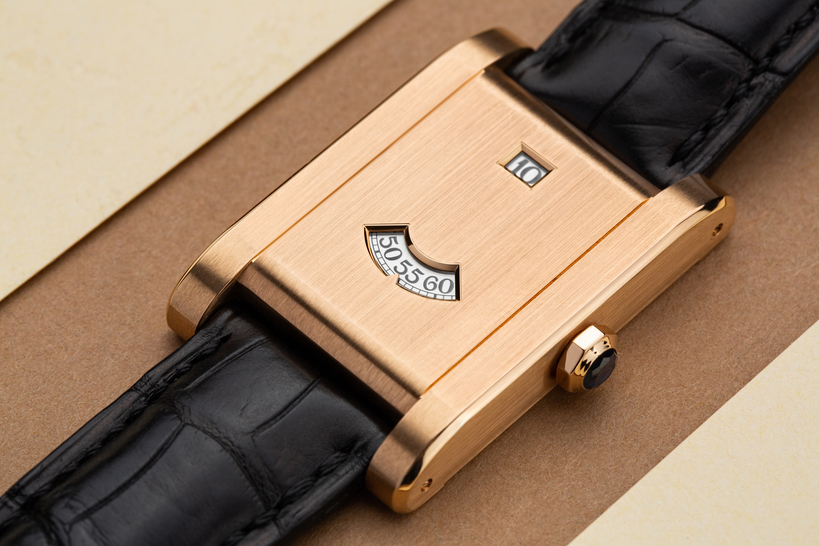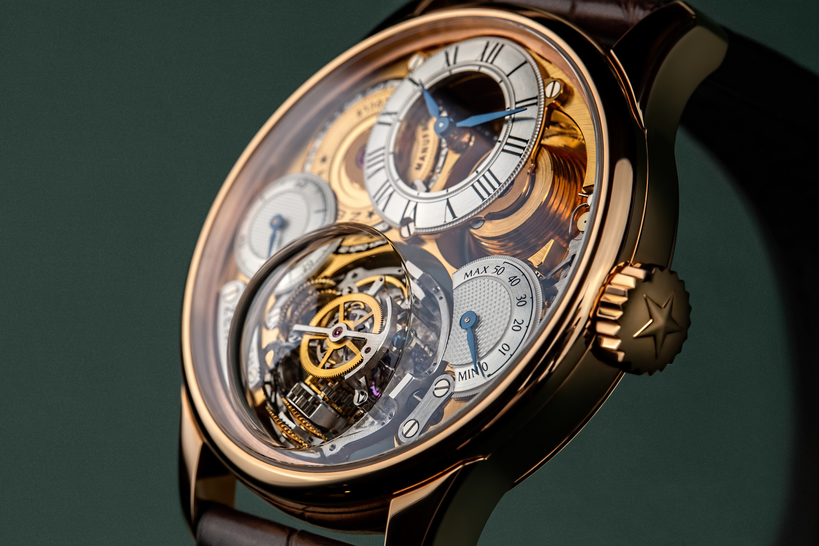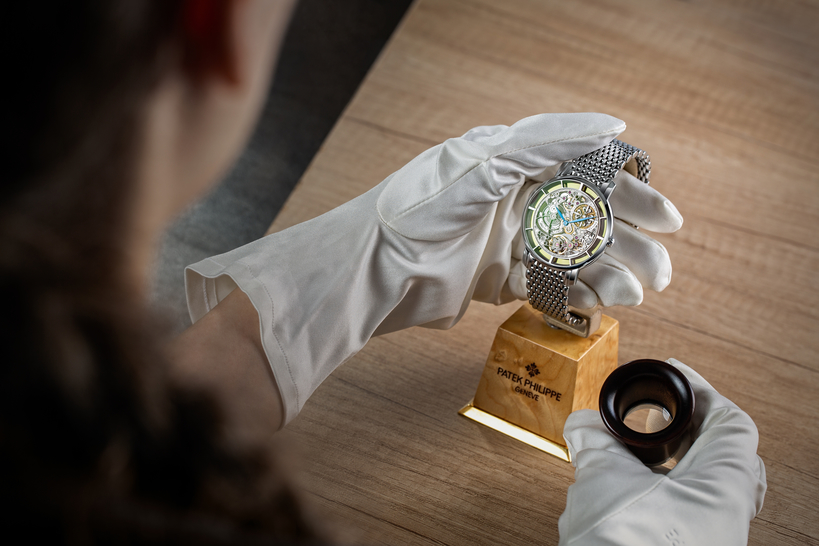Dials created by nature itself.
Watches with stone dials, which were once a rarity, are now becoming more and more popular and coveted on the pre-owned watch market. Why are modern manufacturers turning to them more often?
Everything's Complicated
Stone dials have plenty of appeal. Firstly, they're rare in and of themselves. Secondly, given that each stone's internal structure is unique, they make any watch they grace a pièce unique. Oh, and they're obviously very beautiful.
The reason why watches with stone dials are relatively young (the first wristwatch with a stone dial recently marked its 60th birthday), and why they're still very rarely encountered to this day, can be explained by the fair share of technological difficulties involved in manufacturing them.
Let's start with the fact that it's no easy task to take a chunk of unworked stone and cut an extremely thin slice of it, then flawlessly finish and polish the resulting disk. You need special equipment to do so: machines, milling cutters, gravers, grinding wheels, and specialists who know how to use all of them.
And even then, high-class specialists still can't make these disks as thin as regular dials. A stone dial will be significantly thicker. And this poses a challenge for watchmakers: it forces them to raise the height of hands, i.e. increase the length of the central axis around which the hour and minute hands rotate.
And that's not as simple as it sounds. What could be so hard about extending an axis by 1 millimeter? Well, this axis needs to be made separately and integrated into the movement properly for starters. Moreover, in micromechanics, micrometers are generally the unit of measurement.
One millimeter is a gigantic stretch, which significantly increases the weight of the axis, and consequently increases the load on the entire watch movement. In some cases, this can mean that the movement's gear drive needs to be recalculated. Let's imagine we've already successfully completed all the cutting and grinding, we've made the axis, and recalculated the gear drive.
What do we have to deal with now? Bingo! Increased case height. If we're talking about a small exquisite watch for her, then this factor is of no small importance. Thin quartz watch movements sure do come in handy, but the tweaks that need to be made to accommodate a stone dial won't leave the movement untouched...
The first watchmaker to solve the problems that arise with case height due to the extremely thick stone dial was Piaget, who launched their ultra-thin 9P movement in 1957 which measured just 2 mm in height. That's why some historians consider Piaget to be the pioneer of watchmaking with stone dials.
Who Doesn't Find These Problems Daunting?
The technological and technical problems we've mentioned can only be solved at full-cycle manufactures that cover production from A to Z, and there aren't that many of them. We're talking about today's landscape, but there were even less at the turn of the millennium.
In the early 2000s, only around ten watchmakers could rightly call themselves "manufactures": Rolex, Patek Philippe, Jaeger-LeCoultre, Zenith, Piaget, IWC, A. Lange & Söhne, Girard-Perregaux, Seiko and top Swatch Group brand ETA.
It was only later that everyone who wanted to be considered a great began establishing themselves as manufactures: from Cartier and Hermes to Vacheron Constantin and Audemars Piguet, along with relatively young independent brands by watchmaking standards, such as Parmigiani, Montblanc, De Bethune, Bovet, etc.
But essentially, only the first ten or so companies could single-handedly rise to the technical challenges involved in manufacturing hardstone dials. You're lucky if your company is a member of a happy family in a powerful luxury holding company like the Richemont Luxury Group.
Subsidiaries like Cartier or Van Cleef & Arpels can turn to their partners for particularly important interesting models, and order the necessary movements from Jaeger-LeCoultre or Piaget. Other manufacturers still don't have these opportunities.
It's a good thing that nowadays, availability of stone dials has been normalized by many jewelry makers — both big companies and tiny ones. All of this has resulted in a situation where you can even easily find a stone dial on AliExpress for 6 US dollars. But these manufacturers aren't worried about what you might do with the dials later.
Sometimes They Make a Comeback
So, the first wristwatch with a stone dial was introduced by Maison Piaget in 1963. Their exquisite ladies' watches looked so strikingly luxurious that they were categorized as jewelry watches.
A number of models equipped with the 9P caliber were introduced to the collection in one go, which had medallions that measured under 1 mm in height with openings drilled through them. Piaget chose to debut with hardstones including lapis lazuli, opal, malachite, and tiger's eye.
The appearance of one of these watches on Jackie Kennedy's wrist made a significant contribution to their promotion. Needless to say, other major maisons working at the confluence where haute horlogerie meets haute joaillerie followed Piaget's example — most notably Cartier and Van Cleef & Arpels.
However, despite Piaget's feat, stone novelties didn't make much of an impression on collectors. These were ladies' watches, which weren't seen as valuable collector's items by sexist society at the time. Besides, Piaget hadn't even marked the tenth anniversary of the 9P caliber, and people didn't take this watchmaker seriously yet.
Then the quartz crisis took hold with its ultra-fashionable electronic and liquid-crystal displays. The aesthetic appeal of dials made of semi-precious stones looked likely to be forgotten forever. Moreover, 90 percent of Swiss watch manufacturers went completely bankrupt.
Almost everyone forgot about these dials, except Rolex and Patek Philippe, whose loyal clients continued to appreciate their timeless value, and regularly commissioned watches with hardstone dials or dials fully encrusted with diamonds. This is precisely what helped preserve the necessary traditions and technologies for manufacturing these watches.
The Extraterrestrial King
It's no wonder Rolex ended up being the one who revived the fashion for watches with stone dials in the late 1990s. Rolex actually conducted their first experiments with meteorite dials back in the late 1970s. But the major widespread demand and trend for meteorite dials only took off towards the end of the 1990s.
That was a period when Oyster Day-Date and Cosmograph Daytona models with dials made of meteorite fragments were released one after the other. To this day, theorists are still debating whether dials made of meteorite or mother-of-pearl can be considered "stone dials". As for mother-of-pearl, we have our doubts too, but as for meteorite... Why not?
There are different types of meteorites: some fragments contain unidentified types of rock, while others are predominantly composed of metals. A meteorite called Gibeon, which crashed into the earth in prehistoric Namibia, is classified as an iron meteorite. Gibeon meteorite also happens to be what Rolex uses to make their dials.
Meteorite fragments possess properties which make it similar to working with fragile stone. And even a huge technologically advanced giant like Rolex finds it difficult to make dozens of these dials. A meteorite's crystal structure is extremely unstable, and totally unpredictable.
It often takes at least fifty failed attempts before a one-and-only successful meteorite dial is made. One sure sign that a dial came from out of this world is the Widmanstätten pattern, named after the Austrian mineralogist.
It's a geometrically regular pattern of needles or cross-hatching lines, which can be made visible on the surface of these meteorites by acid etching. This unique pattern on every model is clearly visible on their dials. That's why meteorite watches that Rolex releases from time to time are so highly sought-after by collectors.
Stone Ranking
If we exclude watches with fully diamond- or sapphire-encrusted dials, then the most popular ornamental stone ia black onyx. It's perfectly suited to any luxury "black-tie" watch, which Patek Philippe in particular has quite a lot of.
Multicolored corals, lapis lazuli and aventurine aren't too difficult to work with, and these stones look quite uplifting and mysterious in ladies' models. Tiger's eye is a durable stone with a very unusual bright pattern, and it has a stable structure which makes it easy to work with.
In general, watchmakers use around 50 different semi-precious ornamental stones to make dials, most of which are opaque. And the number of stones used by watchmakers is growing every year. Sometimes you get the impression that armed with modern miracle technologies, watchmakers are capable of making dials from anything imaginable.
The stones aren't that valuable in and of themselves. What is valuable is the meticulous labor that goes into making stone dials, along with the fact that the resulting pieces are guaranteed to be unique.
But the manufacturer's name creates even more value. For example, the phrase "you're looking at a watch with a ferrite (or sodalite, or iron-quartz Eisenkiesel) dial" would probably put a watch community outsider off.
But the hearts of true watch collectors and expert investors skip a beat when they hear the same, just because they know an inside, which could make them a very sucsessful in buying.
The minerals, which may seem utterly incompatible with haute horlogerie, are precisely what Rolex used to make the dials for the Oyster Day -Date President (Ref. 18238, ferrite), Datejust (Ref. 16234, sodalite), and the Day-Date with a President bracelet (Ref. 128235, Eisenkiesel). And these models were released in very limited editions.
Credits taken from: www.h-moser.com, www.girard-perregaux.com, www.rolex.com, www.revolutionwatch.com, www.phillips.com























